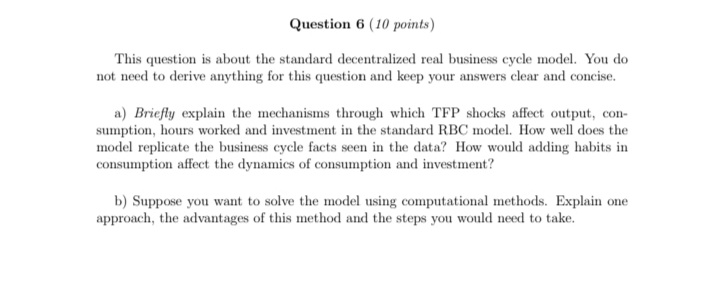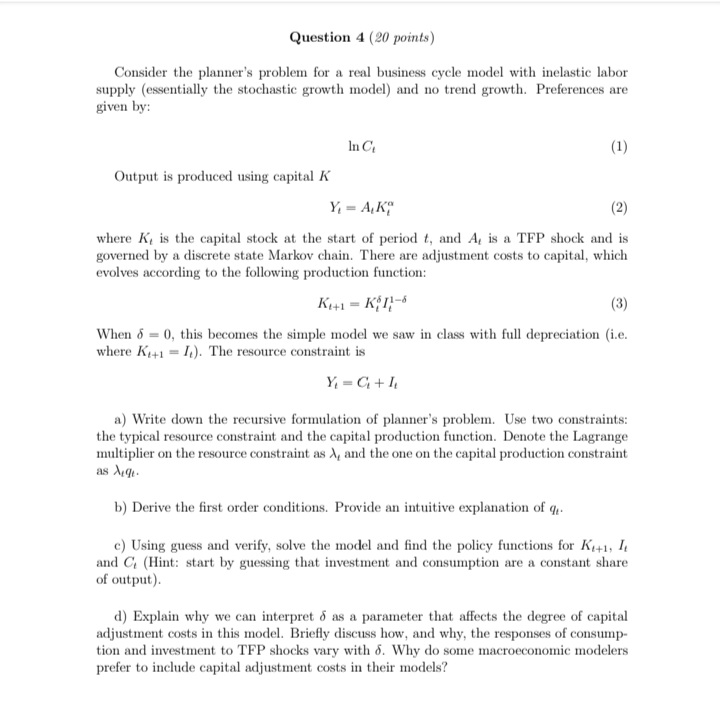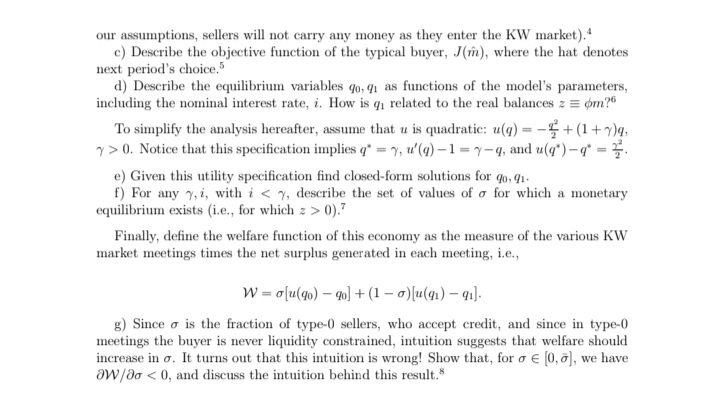Economics theory:
Question 6 (10 points) This question is about the standard decentralized real business cycle model. You do not need to derive anything for this question and keep your answers clear and concise. a) Briefly explain the mechanisms through which TFP shocks affect output, con- sumption, hours worked and investment in the standard RBC model. How well does the model replicate the business cycle facts seen in the data? How would adding habits in consumption affect the dynamics of consumption and investment? b) Suppose you want to solve the model using computational methods. Explain one approach, the advantages of this method and the steps you would need to take.Question 4 (20 points) Consider the planner's problem for a real business cycle model with inelastic labor supply (essentially the stochastic growth model) and no trend growth. Preferences are given by: In C (1) Output is produced using capital K YI = AK, (2) where K, is the capital stock at the start of period t, and A, is a TFP shock and is governed by a discrete state Markov chain. There are adjustment costs to capital, which evolves according to the following production function: (3) When 6 = 0, this becomes the simple model we saw in class with full depreciation (i.e. where Ki+1 = I,). The resource constraint is Y = ath a) Write down the recursive formulation of planner's problem. Use two constraints: the typical resource constraint and the capital production function. Denote the Lagrange multiplier on the resource constraint as A, and the one on the capital production constraint as Age. b) Derive the first order conditions. Provide an intuitive explanation of q. c) Using guess and verify, solve the model and find the policy functions for Ki+1, It and C, (Hint: start by guessing that investment and consumption are a constant share of output). d) Explain why we can interpret o as a parameter that affects the degree of capital adjustment costs in this model. Briefly discuss how, and why, the responses of consump- tion and investment to TFP shocks vary with o. Why do some macroeconomic modelers prefer to include capital adjustment costs in their models?our assumptions, sellers will not carry any money as they enter the KW market).* c) Describe the objective function of the typical buyer, J(m), where the hat denotes next period's choice.5 d) Describe the equilibrium variables go, q as functions of the model's parameters, including the nominal interest rate, i. How is q related to the real balances = = om?" To simplify the analysis hereafter, assume that u is quadratic: u(q) = -4 + (1+7)q, y >0. Notice that this specification implies q* = y, u'(q) -1 = y-q, and u(q")-q" = e) Given this utility specification find closed-form solutions for go, 91. f) For any y, i, with i 0).? Finally, define the welfare function of this economy as the measure of the various KW market meetings times the net surplus generated in each meeting, i.e., W = ou(go) - qo] + (1 - o)[u(g) - qi]- g) Since o is the fraction of type-0 sellers, who accept credit, and since in type-0 meetings the buyer is never liquidity constrained, intuition suggests that welfare should increase in o. It turns out that this intuition is wrong! Show that, for o e [0, a], we have OW/do B - 1. New money is introduced, or withdrawn if a 0 per unit of time, i.e., p does not depend on the worker's type and p > 2, for all i. Also, while a firm is searching for a worker it has to pay a search (or recruiting) cost, pc > 0, per unit of time. All jobs are exogenously destroyed at rate A > 0 (again, independently of the worker's type). All agents discount future at the rate r > 0. Throughout this question focus on steady state equilibria. a) Based only on your knowledge of the environment (i.e., without analyzing the model), explain whether the following statement is true or false: "In this economy, all workers will be paid the same wage, since they are equally productive". b) Write down the value function of a firm with an unfilled vacancy (V) and the value function of a firm matched with a worker of type i (J;). c) Write down the value function of a worker of type i while unemployed (U.) and while employed (W.). d) Combine the free entry condition (i.e., V = 0) with the expressions for J, provided earlier in order to derive the job creation (JC) curve for this economy. e) Using the same methodoly as in the lectures (adjusted to accommodate the differ- ences in the new environemnt), derive the wage curve (WC) for this economy. f) Combine the JC curve and the WC curve determined in the previous parts in order to provide an equation that (implicitly) determines the equilibrium 0. g) Describe the equilibrium wage for a worker of type i (wy) as a fuction of the model's parameters and the equilibrium O (which was implicitly determined in part f). h) Is w; increasing or decreasing in z? What happens to the distribution of equilibrium wages as the distribution of workers' types becomes more dispersed?Question 1 (10 points) Consider the standard deterministic growth model in discrete time. There is a large number of identical households (normalized to 1). Each household wants to maximize life-time discounted utility U((a).) = >#' (Ing + ylna-1), 7>0, 1=0 that is, households preferences are characterized by "habit persistence". Each household has an initial capital stock ro at time 0, and one unit of productive time in each period, that can be devoted to work. Final output is produced using capital and labor services, ye = F(k, n ) = kina. This technology is owned by firms whose number will be determined in equilibrium. Output can be consumed (c) or invested (i,). We assume that households own the capital stock (so they make the investment decision) and rent out capital services to the firms. We also assume that the capital stock (r,) fully depreciates at the end of a given period, i.e. 6 = 1. Finally, it is assumed that households own the firms, i.e. they are claimants to the firms' profits. a) In this economy, why is it a good idea to describe the AD equilibrium capital stock allocation by solving the (easier) Social Planner's Problem? b) Fully characterize (i.e. find a closed form solution for) the equilibrium allocation of the capital stock.' c) What is the capital stock equal to as t -+ co? What is the ADE value of the rental rate of capital and the rental rate of labor as t - co












